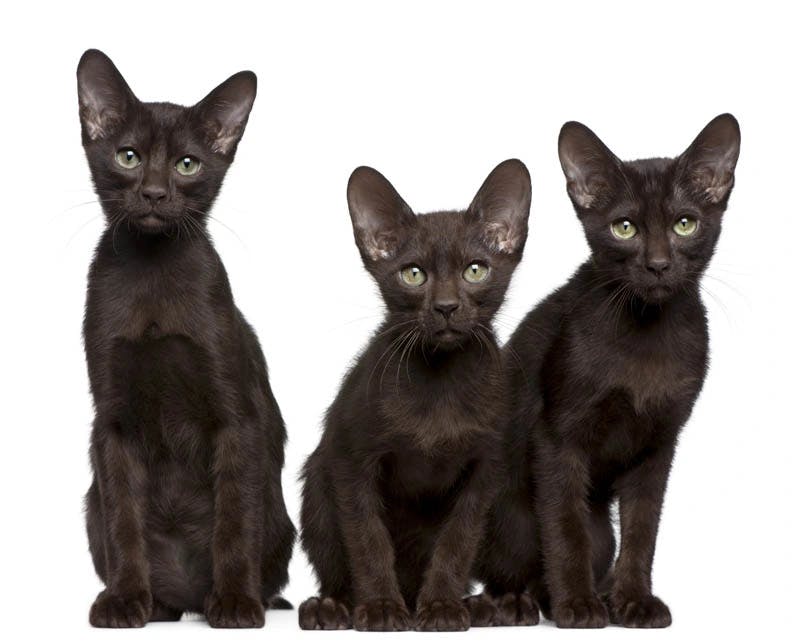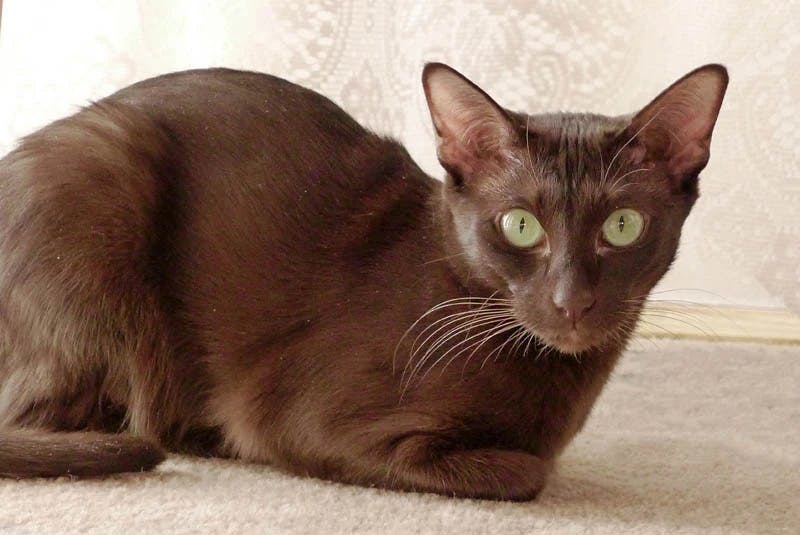Havana Brown cat
Color of Chocolate Kisses Touches You with Its Paws of Love
Havana Brown Cat
Jon Crimes - Last Updated on December 18th, 2021
What you Need to Know about the Havana
The Havana Brown cat is a striking breed with a coat the color of pure chocolate and brilliant green eyes. This cat will melt the heart of anyone it meets.
Its coat is short and smooth with graceful lines that add to the elegance of this beautiful cat.
The Havana Brown cat is a moderate-sized, muscular, and short-haired feline. Males are larger than females and can weigh from eight to ten pounds. Expect females to weigh between six and eight pounds.
Are Havana Brown cats rare?
Havana Browns are still quite rare and have been considered an endangered species. But they have built a solid following of enthusiastic admirers for very good reasons.

Appearance Matters. What does a Havana look like?
The Havana Brown profile looks like a series of straight lines that highlight a sudden stop of the nose. You will hear the nose being described as ‘rolled cigar’ shape or even looking like a corn-cob.
Full whisker pads and a pinch at the muzzle complete this unique look. Combined with a square chin, a blunt, rounded face is the result. The entire head and muzzle have been described as being the shape of a light bulb.
Color is very important to this breed. The coat should be a rich, even shade of warm brown. It tends toward red-brown rather than a black and brown cat look. They also have a very distinctive head with forward-tilted ears that convey a sense of permanent alertness.
Havanas have no undercoat. Ghost brown tabby cat markings can appear in kittens but ideally, they will fade out with time.
This dark brown cat's firm, flexible muscular structure ripples under its shining coat. All this completes the look of a beautiful cat with a powerful sense of grace.
It's all Personal. The Havana Brown Character
Affectionate, gentle, and intelligent sums up the Havana Brown cat personality quite nicely.
Despite sharing some resemblance, they have different personalities to the Siamese breed.
Agreeable and adaptable, this cat is a playful kitten throughout life. They will use their paws in both endearing and entertaining ways. Havanas crave attention from their human companions. They are not content unless they can be by your side, helping you with all your everyday tasks.
Havanas can be independent. But they all have an endearing trait of reaching out to touch you, offering a paw of friendship. A favorite Havana Brown occupation is one of retrieval. They can often be found carrying toys and other stray objects around in their mouths.
If you can’t locate a sock or some other small, easy-to-carry object, check your Havana's cat bed. You might find that your missing object has found its way there. They are a bit like packrats in this regard!
There seems to be a fair amount of personality variation among Havana's. But they are 'little thieves' who love to make up their own games. A piece of paper falling to the floor from the printer may quickly become airborne again if this cat is around.
There is no need to buy toys for Havanas. They will make (or steal!) their own and use their paws to put on a show!
Caring for your Havana
The Havana Brown cat is not prone to excessive shedding and weekly brushing is all their coats need.
Whilst they are not completely hypoallergenic, they are short-haired cats. This should help with allergies making them a better choice than longer-haired breeds. Spend some time around these cats before taking one home to make sure.
Other grooming requirements include trimming of nails and regular monitoring of ear cleanliness. Don’t forget to check their eyes regularly as well and wipe away any natural discharge.

The Health and Happiness of your Havana
Havana Browns are generally healthy cats.
Saying that because of the breeding, Havana's can be susceptible to some genetic conditions.
These include:
- Urinary tract infections. This is a group of conditions that are called Feline Lower Urinary Tract Diseases (FLUTD). Bladder stones are a prime concern for the Havana Brown and would require veterinary care. Look out for symptoms such as urinating outside the litter tray, or your cat being unable to pee.
- Hypertrophic cardiomyopathy. The breed can be susceptible to thyroid problems. This can damage the heart and lead to hypertrophic cardiomyopathy. There is a genetic test available for this HCM condition.
- Arterial Thromboembolism. This condition is blood clots in the arteries of the heart. Hind leg paralysis is an indicator that this is happening to a cat and emergency treatment would be required.
The Havana Brown can be prone to overeating if not monitored closely. They are quite active cats but they also need some playtime and exercise as part of their routine. This will help to keep them on the right side of cat obesity.
Look after your Havana Brown and they will enjoy playful antics throughout their life. Expect this cat to live between 10 and 15 years on average.
How Much Does a Havana Brown Cat Cost?
The beautiful green eyes and smooth short coats of these cats make them the perfect pets. If you are interested in getting one you must be wondering about their price. Havana Brown kittens for sale usually go for between $500 and $1,300 but it can go even higher than that sometimes.
The price will depend on the breeder, the age of the cat, its location, and even its markings. Naturally, the pedigree will also play a role.
These cats can also be somewhat rare, so finding a good breeder can be hard. You can always check our list for that.
Feline History. Where does Havana come from?
The Havana Brown is another breed that has descendants from Siam (now Thailand). The people of Siam considered brown cats to be very beautiful. They also believe that they protect humans from evil, so brown cats are held in the highest regard.
The Havana was developed by breeders using the Siamese and domestic shorthairs. A touch of Russian Blue was also added to the breeding efforts.
Their goal was to produce a solid-colored cat in the chocolate point coloring of the Siamese. This was to be different from the sable coloring of the Burmese.
Initially, the breed was named the Chestnut Brown Foreign. Later, it was re-named Havana.
The Havana was accepted for registration by the Cat Fanciers’ Association (CFA) in 1959. Championship status was granted in 1964.
